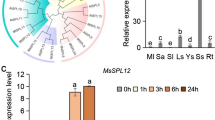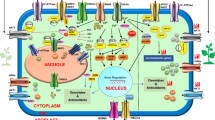Abstract
Although plant rare cold inducible 2 (RCI2), a homolog of yeast PMP3, has been considered to play important roles in responses to abiotic stress in plants, the functional role of RCI2 in salt-stress tolerance remains largely unknown for crop plants. In this study, we determined the function of CsRCI2H from Camelina under salt stress. Subcellular localization analysis of the yellow fluorescent protein (YFP)-CsRCI2H fusion protein revealed that CsRCI2H localizes to the plasma membrane in tobacco leaves. Expression of CsRCI2H was greatly increased in the presence of 150 mM NaCl. CsRCI2H compensated for the salt sensitivity of the yeast mutant ∆pmp3 lacking the PMP3 gene. CsRCI2H-overexpressing transgenic Camelina showed improved seed germination, root growth and fresh weight under high salt stress. CsRCI2H-overexpressing transgenic Camelina displayed lower accumulation of Na+ in the roots and shoots but higher K+ and Ca2+ accumulation in the shoots than wild type plants under salt stress. Furthermore, CsRCI2H-overexpressing Camelina displayed higher stomatal conductance and lower malondialdehyde under salt stress. Transcript levels of ion-homeostasis related genes, such as CsSOS1, CsSOS3, and CsHKT1, were significantly increased in the CsRCI2H-overexpressing transgenic plants upon salt treatment. These results suggest that Na+ and K+ homeostasis can be controlled by the Na+ and K+ transport systems throughout the CsRCI2H-overexpressing transgenic Camelina plant under salt-stress conditions. Collectively, these results indicate that CsRCI2H contributes to salt tolerance in Camelina during seed germination and seedling growth by reducing Na+ toxicity in the plant cells via regulation of ion homeostasis.







Similar content being viewed by others
References
Ben Romdhane W, Ben-Saad R, Meynard D, Verdeil JL, Azaza J, Zouari N, Fki L, Guiderdoni E, Al-Doss A, Hassairi A (2017) Ectopic expression of Aeluropus littoralis plasma membrane protein gene AlTMP1 confers abiotic stress tolerance in transgenic tobacco by improving water status and cation homeostasis. Int J Mol Sci 18:692
Ben-Romdhane W, Ben-Saad R, Meynard D, Zouari N, Mahjoub A, Fki L, Guiderdoni E, Al-Doss A, Hassairi A (2018) Overexpression of AlTMP2 gene from the halophyte grass Aeluropus littoralis in transgenic tobacco enhances tolerance to different abiotic stresses by improving membrane stability and deregulating some stress-related genes. Protoplasma 255:1161–1177
Brown APC, Dunn MA, Goddard NJ, Hughes MA (2001) Identification of a novel low-temperature-response element in the promoter of the barley (Hordeum vulgare L.) gene blt101.1. Planta 213:770–780
Capel J, Jarillo JA, Salinas J, Martinez-Zapater JM (1997) Two homologous low-temperature-inducible genes from Arabidopsis encode highly hydrophobic proteins. Plant Physiol 115:569–576
Chang-Qing Z, Shunsaku N, Shenkui L, Tetsuo T (2008) Characterization of two plasma membrane protein 3 genes (PutPMP3) from the alkali grass, Puccinellia tenuiflora, and functional comparison of the rice homologues, OsLti6a/b from rice. BMB Rep 41:448–454
Goddard NJ, Dunn MA, Zhang L, White AJ, Jack PL, Hughes MA (1993) Molecular analysis and spatial expression pattern of a low-temperature-specific barley gene, blt101. Plant Mol Biol 23:871–879
Gulick PJ, Dvorak J (1992) Coordinate gene response to salt stress in Lophopyrum elongatum. Plant Physiol 100:1384–1388
Heath RL, Packer L (1968) Photoperoxidation in isolated chloroplasts. I. Kinetics and stoichiometry of fatty acid peroxidation. Arch Biochem Biophys 125:189–198
James RA, Blake C, Byrt CS, Munns R (2011) Major genes for Na+ exclusion, Nax1 and Nax2 (wheat HKT1;4 and HKT1;5), decrease Na+ accumulation in bread wheat leaves under saline and waterlogged conditions. J Exp Bot 62:2939–2947
Ji H, Pardo JM, Batelli G, Van Oosten MJ, Bressan RA, Li X (2013) The salt overly sensitive (SOS) pathway: established and emerging roles. Mol Plant 6:275–286
Keisham M, Mukherjee S, Bhatla SC (2018) Mechanisms of sodium transport in plants—progresses and challenges. Int J Mol Sci 19:647
Kim HS, Lee JE, Jang HY, Kwak KJ, Ahn SJ (2016) CsRCI2A and CsRCI2E genes show opposite salt sensitivity reaction due to membrane potential control. Acta Physiol Plant 38:1–13
Kim YO, Kang H, Ahn SJ (2019) Overexpression of phytochelatin synthase AtPCS2 enhances salt tolerance in Arabidopsis thaliana. J Plant Physiol 240:153011
Kroemer K, Reski R, Frank W (2004) Abiotic stress response in the moss Physcomitrella patens: evidence for an evolutionary alteration in signaling pathways in land plants. Plant Cell Rep 22:864–870
Liu JP, Ishitani M, Halfter U, Kim CS, Zhu JK (2000) The Arabidopsis thaliana SOS2 gene encodes a protein kinase that is required for salt tolerance. Proc Natl Acad Sci USA 97:3730–3734
Liu B, Feng D, Zhang B, Mu P, Zhang Y, He Y, Qi K, Wang J, Wang H (2012) Musa paradisica RCI complements AtRCI and confers Na+ tolerance and K+ sensitivity in Arabidopsis. Plant Sci 184:102–111
Lu C, Kang J (2008) Generation of transgenic plants of a potential oilseed crop Camelina sativa by Agrobacterium-mediated transformation. Plant Cell Rep 27:273–278
Marschner H (1995) Mineral nutrition of higher plants, 2nd edn. Academic Press, New York, pp 527–528
Medina J, Ballesteros ML, Salinas J (2007) Phylogenetic and functional analysis of Arabidopsis RCI2 genes. J Exp Bot 58:4333–4346
Mitsuya S, Taniguchi M, Miyake H, Takabe T (2005) Disruption of RCI2A leads to over-accumulation of Na+ and increased salt sensitivity in Arabidopsis thaliana plants. Planta 222:1001–1009
Mitsuya S, Taniguchi M, Miyake H, Takabe T (2006) Overexpression of RC12A decreases Na+ uptake and mitigates salinity induced damages in Arabidopsis thaliana plants. Physiol Plant 128:95–102
Navarre C, Goffeau A (2000) Membrane hyperpolarization and salt sensitivity induced by deletion of PMP3, a highly conserved small protein of yeast plasma membrane. EMBO J 19:2515–2524
Navarre C, Ghislain M, Leterme S, Ferroud C, Dufour JP, Goffeau A (1992) Purification and complete sequence of a small proteolipid associated with the plasma membrane H+-ATPase of Saccharomyces cerevisiae. J Biol Chem 267:6425–6428
Pask A, Pietragalla J (2012) Leaf area, green crop area and senescence. In: Pask A, Pietragalla J, Mullan D, Reynolds M (eds) Physiological breeding II: a field guide to wheat phenotyping. CIMMYT, Mexico, pp 58–62
Qi Z, Spalding EP (2004) Protection of plasma membrane K+ transport by the salt overly sensitive1 Na+-H+ antiporter during salinity stress. Plant Physiol 136:2548–2555
Quan R, Lin H, Mendoza I, Zhang Y, Cao W, Yang Y, Shang M, Chen S, Pardo JM, Guo Y (2007) SCABP8/CBL10, a putative calcium sensor, interacts with the protein kinase SOS2 to protect Arabidopsis shoots from salt stress. Plant Cell 19:1415–1431
Rahnama A, James RA, Poustini K, Munns R (2010) Stomatal conductance as a screen for osmotic stress tolerance in durum wheat growing in saline soil. Func Plant Biol 37:255–263
Rocha PS (2016) Plant abiotic stress-related RCI2/PMP3s: multigenes for multiple roles. Planta 243:1–12
Shi H, Quintero FJ, Pardo JM, Zhu JK (2002) The putative plasma membrane Na+/H+ antiporter SOS1 controls long-distance Na+ transport in plants. Plant Cell 14:465–477
Xiang C, Han P, Lutziger I, Wang K, Oliver DJ (1999) A mini binary vector series for plant transformation. Plant Mol Biol 40:711–717
Acknowledgements
This study was supported by grants from Water Management Research Program Infrastructure and Transport of the Korean Government (18AWMP-B114119-03) and the Basic Science Research Program through the National Reasearch Foundation (NRF) of Korea, funded by the Ministry of Education (NRF-2018R1D1A1B07045677).
Author information
Authors and Affiliations
Corresponding author
Additional information
Publisher's Note
Springer Nature remains neutral with regard to jurisdictional claims in published maps and institutional affiliations.
Electronic supplementary material
Below is the link to the electronic supplementary material.
11816_2020_622_MOESM2_ESM.pptx
Fig. S1. Sequence comparison of CsRCI2H, AtRCI2H (Arabidopsis thaliana), and ScPMP3 (Saccharomyces cerevisiae). a Amino acid residues identical those of CsRCI2D sequence are indicated by asterisks. Dashes represent gaps inserted into the sequences for optimal alignment; TMD represents putative transmembrane domains. b Nucleotide sequence alignment of CsRCI2H, AtRCI2H, and ScPMP3. Fig. S2. Confirmation of the overexpression of CsRCI2H in transgenic Camelina. The transcript level of CsRCI2H was quantified by real-time RT-PCR analysis.
Rights and permissions
About this article
Cite this article
Kim, YO., Lim, HG., Kim, HS. et al. Overexpression of CsRCI2H enhances salt tolerance in Camelina sativa (L.). Plant Biotechnol Rep 14, 439–449 (2020). https://doi.org/10.1007/s11816-020-00622-9
Received:
Accepted:
Published:
Issue Date:
DOI: https://doi.org/10.1007/s11816-020-00622-9




